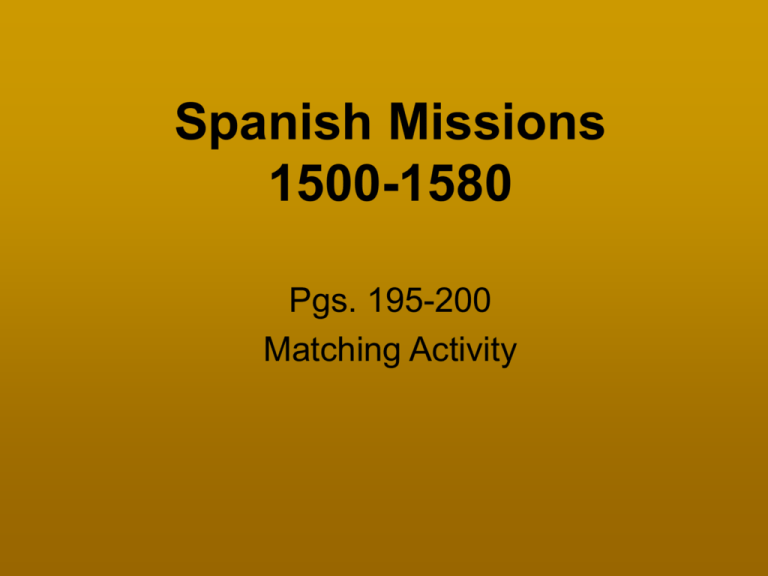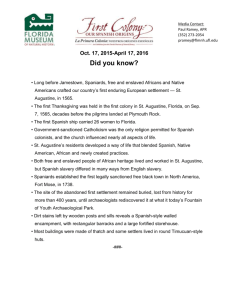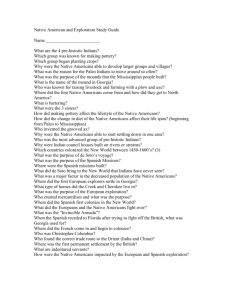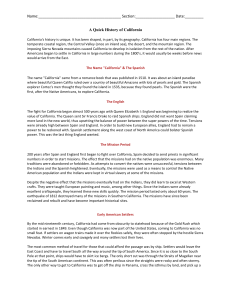Spanish Missions 1500-1580
advertisement

Spanish Missions 1500-1580 Pgs. 195-200 Matching Activity Spanish Conquistadors • The Spanish Conquistadors who explored America found gold and silver. • Mining for gold and silver became the most important money-making activity in Spain’s American colonies. • To protect its gold and silver mines, the Spanish built presidos. • A presido is a fort built in a buffer (land that serves as a barrier) for protection St. Augustine • The largest and most important presidio was named St. Augustine. • It was located on the Atlantic coast of Florida on a bay first explored by Ponce de Leon. • St. Augustine was built in 1565. • It was the first permanent European settlement in America. • It was founded 42 years before the English landed at Jamestown. Building St. Augustine • The Spanish were fearful of English pirates and Indian raiders. • To strengthen St. Augustine, they built stone walls around the wooden fort. • It took 25 years to complete. • St. Augustine served as Spain’s military headquarters in North America. Spain’s Interest in America 1. Grow the Spanish empire. 2. Expand its economy. 3. Spread the Catholic faith Ranches and Haciendas • Realizing that gold was scarce, many Spanish settlers made money by raising livestock and selling the hides and animal fats to nearby markets. • Settlers often traded with the Pueblo Indians for corn, pottery, and cloth. • Settlers built large haciendas or houses where they raised thousands of cattle and sheep. • The settlers wanted to be self-sufficient. Indian Tribes • The settlers brought horses (long extinct) to America which changed the life of the Plains Indians. • The Plains Indians learned to tame the horses and use them as transportation which helped them in hunting and warfare. • The Navajos learned to raise sheep and weave the wool into colorful clothing and blankets. Spanish Missions • The first Spanish Mission was Nombre de Dios or Name of God. • It was built near St. Augustine in 1565. • It was the first in a chain of missions that would link the Atlantic coast to the Pacific. • Father Junipero Serra, a Spanish missionary, helped build a string of 21 missions in California. Spanish Missions • When the Spanish built a mission, it included a church, ranch and farm buildings. • Some missions were built near Indian villages. • The Spanish would bring livestock, fruit trees, and seeds for crops. • The goal was for the mission to become self-sufficient. Relations with the Indians • The Spanish and Indians learned from one another. • The Indians taught the Spanish how to build adobe houses and how to use herbs as medicines. • The Spanish taught the Indians how to guide a plow instead of using a stick and hoe in the Indian way. Relations with the Indians • Over time relations between the Spanish and Indians changed. • Many Indians were forced to give up their religious traditions, many were forced to work against their will, and missionaries used cruel treatment to control the Indians. • Some Indians fought back killing missionaries and destroying churches. El Camino Real • To protect its missions the Royal Road (El Camino Real) was built to connect missions with presidos. • The first section was built in the middle 1500s and stretched for more than 600 miles. • Many cities such as San Antonio, Texas and San Diego, California began as missions.






